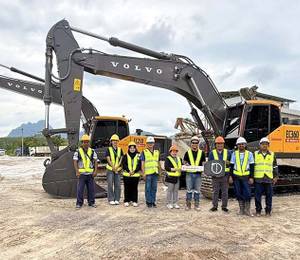The Centre for Additive Manufacturing (AM.NUS) at the National University of Singapore has launched the AM.NUS Construction 3D Printing Programme to accelerate the adoption of 3D printing building technology in the construction industry. The programme, hosted under the School of Design and Environment (SDE) at NUS and supported by the National Additive Manufacturing Innovation Cluster (NAMIC), will develop sustainable materials and 3D printing designs to facilitate rapid mass production of building structures.
The new AM.NUS Construction 3D Printing Programme will help to realise the value of 3D printing in the construction sector, and establish an ecosystem of construction 3D printing capabilities in Singapore through cutting-edge research and collaborations with the industry. The programme also aims to provide training on construction 3D printing to NUS students and industry partners, as well as organise events such as conferences and workshops in the construction 3D printing space to encourage knowledge sharing in the area.
In addition, a construction 3D printing laboratory has been established as part of the programme and will house Singapore’s largest gantry type concrete 3D printing machine. The technology will be employed to test novel building designs and materials with the aim to develop concrete structures that can be easily mass produced by 3D printing in a sustainable manner. Both the programme and laboratory will be based at SDE with researchers working closely with the industry on a range of research projects.
The AM.NUS Construction 3D Printing Programme has since embarked on two research projects:
3D printed toilet units to improve sanitation in India
The first is a 3D printed toilet project carried out in collaboration with the NAMIC and the Hamilton Labs to accelerate the production of toilet units in India and improve sanitation in the country.
Researchers from the AM.NUS Construction 3D Printing Programme have reportedly developed a novel toilet unit design that can be 3D printed in under five hours, which currently takes a day to build manually. The new toilet unit is also said to be 25% cheaper to produce by 3D printing.
The construction of a 3D printed toilet unit has since been completed at NUS, and will be shipped to India for installation in future. The researchers will also look into incorporating recycled materials in the concrete used to construct these toilets in the next phase.
According to NUS, the team has conducted thorough field studies in different parts of India to develop this 3D printed toilet that addresses the challenges of building a toilet in the country – from construction, transportation to installation. Each toilet unit is made up of 12 smaller modules that can be transported to the destination where the toilet unit will be assembled and installed. Such simple design makes it easier for workers to complete the assembly and installation.
3D printed volumetric formwork
The second project is the development of 3D printed volumetric formwork for bathroom units – it is believed to be the first in the world. Formworks for concrete constructions are traditionally made with steel or timber and currently, it takes almost a day to complete the construction of a typical HDB (Singapore public housing) bathroom unit.
The new formwork, which replaces steel and timber with a polymer, could potentially construct up to 24 bathroom units in a day with the use of semi-automated production line. NUS said the researchers are now working with local authorities and a local firm to advance the project.
Website: http://am.nus.edu.sg












